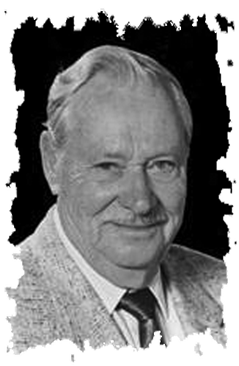| HOME | KIDSROCK | TEENSROCK | GEOTOURS |

| History of Rock |
Exploration and Mining |
Directions | Opportunity Rocks! |
GeoTours | Legends of Rock |
Geology FAQs |
More to X-plore! |
Geo-Links | Explore Manitoba |

Article modified and reprinted with permission from the Northern Miner November 18, 2007, pg. 4, April 18, 2013
Mining wouldn’t be what it is today without the incredible ingenuity of Winnipeg-born Frederick William Wink, entrepreneur and inventor of the portable diamond drill known as ‘The Winkie’. In addition to inventing three kinds of drills, Wink built several successful companies, met four Canadian prime ministers and four U.S. presidents, and was invited by the late U.S. president John F. Kennedy to oversee development programs in West Africa. Born in 1914, Wink moved to Red Lake, Ontario to work as a cook at the Howie Red Lake gold mine at the age of 20. After going underground to assist a diamond driller, Wink liked the work enough to get promoted to operator within six months, then moved on to become a skilfull diamond-bit setter. In 1943, Wink headed for the oil fields of Alberta, then opted for a drilling assignment in Yellowknife, N.W.T. From Yellowknife he headed abroad to Brazil, where he taught himself to read and write Portuguese and formed a successful diamond-drilling company. Among other successes, Wink's company drilled the world's largest manganese deposit. In 1950, after a call from the 14th President of Brazil, Getùlio Vargas, Wink was appointed consultant to the Brazilian mining industry and given an office in the presidential palace.While in Brazil, Wink also set up a mining school for students seeking to learn the diamond drilling business, and since he paid his students to attend, the school proved popular. |
 |
Years later, while still in San Francisco, Wink wrote a letter to then-president Kennedy, offering his services overseas. Three months later, he was invited to the White House, where he was offered a chance to travel throughout West Africa to assess what kind of direct aid was needed. While advising the U.S. government on aid suggestions, he naturally promoted ‘The Winkie’ drill. During the next seven years, Wink circled the globe three times on various trade missions for Canada; visiting such places as Malaysia, Borneo, Thailand, India, Africa and South America. Between 1961 and 1969, Wink travelled to 54 different countries. In 1973, Wink conceived and built the Hydro-Wink diamond drill, a machine capable of drilling to 1,000 ft. below surface. Powered by a Volkswagen engine, the drill extracts NQ size core (47.6 mm in diameter) and can be used as an auger. Wink sold the manufacturing and sales rights to E.J. Longyear, which marketed it as the Longyear 28. While consulting in French Polynesia in the late 1970s, blocking out a phosphate deposit, Wink envisaged a new kind of vibrating drill that would cut through unconsolidated sands and gravels like butter. It became the Vibra-Core drill. Powered by a small lawnmower engine, the 25-lb. drill featured an off-balance "sonic head" that could spin at 12,000 rpm, resulting in a fast vibration that drove the core barrel into the earth to retrieve uncontaminated core. Junior Freegold Recovery used the Vibra-Core in the late 1980s to test the old gold tailings at the Campbell Red Lake mine, in northwestern Ontario. The Geological Survey of Canada tested the Vibra-Core in the Beaufort Sea. |
 |
